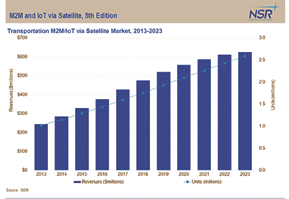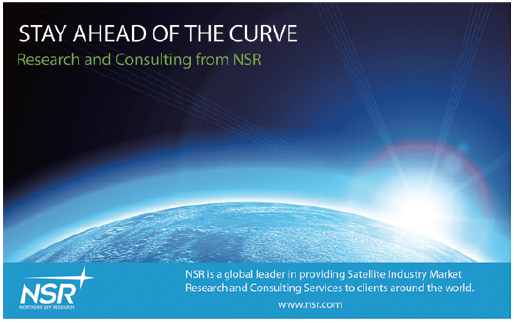Transportation represents the lion’s share of the satellite M2M/IoT market, with more than 44 percent of total units and over 20 percent of total satellite M2M/IoT market revenues.

With the mass market of deeper analytics tools now taking hold across the Transportation sector, its dominance affects the entire market more than ever. To what extent will big data push the limits of M2M via satellite? And what sort of bandwidth requirements are we looking at?
Using data from NSR’s recently released M2M and IoT via Satellite, 5th Edition report (http://www.nsr.com/research-reports/satellite-communications/m2m-and-iot-via-satellite-5th-edition/), the Transportation sector is poised for strong growth, growing from $245 million in annual revenues in 2013 to a forecasted $625 million by 2023, for a CAGR of 9.8 percent.
North America continues to dominate here, taking up just under 61 percent of the market in 2013. However, this is expected to decline to 52 percent by 2023 as other regions of the world get up to speed in this industry, fleets continue to modernize, and global shipping and transport continues to shift focus toward APAC.
Growth within the M2M sector is expected to be particularly robust in regions that lack a developed terrestrial communications infrastructure, most notably Latin America and Africa/Middle East regions, with CAGRs of 9.9 percent and 8.9 percent, respectively. With the Transportation and Cargo sectors in control of high-value goods, high reliability with high-end SLAs are compulsory for most users of M2M services.
This requirement is forecast to rise in the future, with the increasing use of data analytics. In the Transportation sector, there is an increasing demand for keeping track of literally everything that’s trackable, to discover any insight possible to assist in optimizing businesses—often referred to as ‘big data’ or ‘deep analytics.’
Because of its nature, these requirements will drive up bandwidth needs for M2M services, as anything and everything will begin to be monitored, with reporting frequencies in minutes rather than in hours. Although specific platforms remain narrowband—and NSR believes this to remain the long-term case—the aggregate number of connections is pushing satellite requirements slowly higher. Packet sizes here continue to remain in the bytes to lower kilobytes range.
Usage of deep analytics data can pay huge dividends for end-users. In the aeronautical sector, for instance, tracking of near real-time engine telemetry to see continuous performance of an engine using M2M via satellite, can assist in reducing maintenance from a fixed schedule to times when maintenance is actually required—a ‘just-in-time’ model, in other words. These savings can be huge and are driving up M2M units across the board.
Fleet management companies are also implementing satellite M2M technologies for the same purpose of maintenance, and in some cases this is combined with broadband access for drivers’ entertainment in long-distance hauls. This is critical to reducing employee churn, which annually can amount to over 100 percent of the workforce—a significant investment with a significant return.
What does this mean for operators? Satellite M2M providers will need to get on board and develop, or acquire, deep analytics application layers in order to thrive in this sector in the future. In terms of frequency, HTS usage is still forecast to remain minimal for the M2M sector—approximately 1 percent of revenues in 2023—next generation L-band systems such as Iridium NEXT having the advantage for big data in the Transportation vertical, in order to handle higher volumes of narrowband connections.
Despite M2M/IoT often being considered more of a “niche” market for satellite operators, the sheer size of the total addressable market moving forward means that even a small percentage of the total leads to significant revenues.

While a number of different applications will see demand growth, Transportation, in particular, does offer significant opportunities through the consistent need for companies to innovate and improve processes through tracking and the use of “big data,” where higher numbers of narrowband connections will become the new normal.
The NSR infosite is located at http://www.nsr.com/
Mr. Crisp joined NSR in 2014, following a Hong Kong based engineering role at Aurecon. Mr. Crisp is the co-author of NSR’s annual Direct-to-Home (DTH) Markets report. As a member of NSR’s Fixed Satellite Services (FSS) group, Mr. Crisp’s areas are comprised of M2M communications, including the terrestrial M2M landscape.


